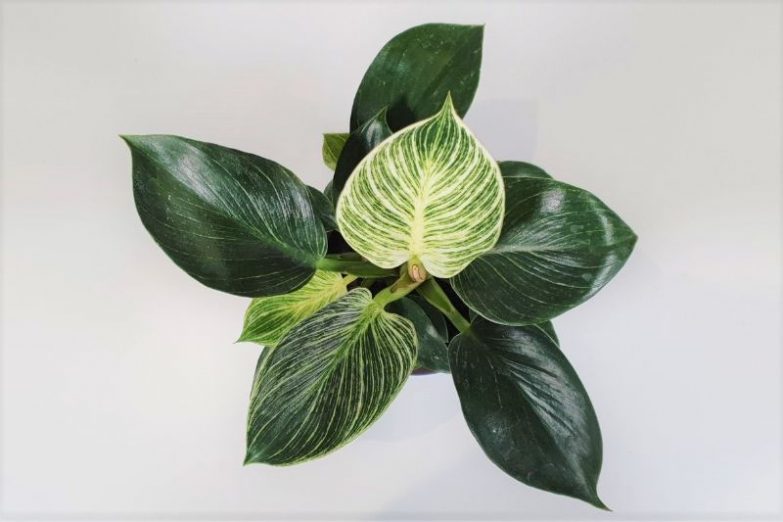Philodendron Birkin is such an interesting and beautiful houseplant, with white striped variegation on dark-green waxy leaves that really looks spectacular. This article covers everything you need to know about Philodendron Birkin care, including how to prevent and fix all the common problems, and keep your plant thriving and happy.
Philodendron Birkin care requirements include bright, indirect light, humidity of 40-70%, and well-draining soil. Water once the top inch of soil dries out, maintain temperatures of 60-85°F(16-30°C), avoid drafts, and fertilize lightly every 2-4 weeks during spring and summer.
Philodendron Birkin Overview
Philodendron Birkin has an interesting history, even though it hasn’t been around too long. It came into existence as a spontaneous mutation during the cultivation of Philodendron Rojo Congo. Delighted with the impressive variegation of this unexpected plant, the grower put this beauty into full production.
Initially in high demand and short supply, Philodendron Birkin used to command eye-watering prices, but thanks to mass production through tissue culture, it’s now widely available and very affordable in most parts of the world.
You may also see Philodendron Birkin sold as Philodendron ‘White Wave’, and as a non-patented cultivar, its possible further trade names or common names may spring up over time.
An interesting characteristic of Philodendron Birkin is that it’s variegation is unstable, and over time it can produce one or more leaves that look just like its parent plant, the Philodendron Rojo Congo. It has also been known to produce almost completely white leaves, ones with a splash of pink, or it can revert to being completely green.
All this makes for a very interesting and beautiful plant. Thankfully, it’s also fairly easy to care for, so it won’t be too challenging to grow yours into an impressive specimen.
Philodendron Birkin Care Summary
| Name | Philodendron Birkin (Philodendron ‘White Wave’) |
| Origin | Cultivated variety of Philodendron Rojo Congo |
| Light Requirements | Bright, indirect light. More extensively variegated specimens require brighter conditions. |
| Watering | Wait until at least the top inch of soil feels dry, then water thoroughly. Avoid overwatering. |
| Soil | Use a well-draining potting mix that doesn’t dry out too quickly. A mix of 2/3 potting mix and 1/3 perlite works well, although a specialist Aroid mix is ideal. |
| Temperature | Philodendron Birkin will do well in temperatures of 60-85°F(16-30°C). Avoid drafts. |
| Fertilizer | Fertilize every 2-4 weeks during spring and summer. I use a balanced, water-soluble fertilizer at half strength. |
| Humidity | Does best in humidity of 40-70%, but reasonably tolerant of lower humidity levels. |
| Pruning | Pruning is only required to remove dead or damaged leaves. |
| Propagation | Philodendron Birkin can be propagated from stem cuttings in water or soil. |
| Re-Potting | Repot once showing signs of becoming rootbound to avoid restricting growth. |
| Diseases and Pests | Overwatering can increase the risk of bacterial blight and bacterial leaf spot. Reasonably pest resistant, but spider mites, mealybugs, scale, and thrips can cause issues. Check your plant regularly and treat promptly. |
| Toxicity | Mildly toxic to humans and animals. |
| Where To Buy | Buy Philodendron Birkin online at Etsy (I buy most of my houseplants from Etsy). |
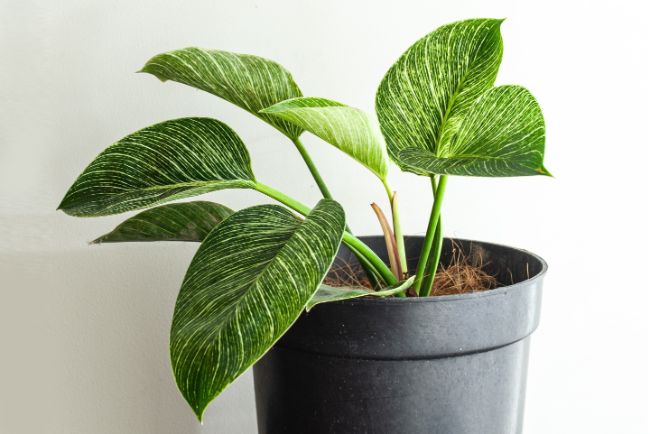
Philodendron Birkin Light Requirements
Philodendron Birkin does best when grown in bright, indirect light. Position your plant near a window to ensure it gets the light it needs to grow, but avoid direct sunlight to prevent scorched leaves.
There can be considerable variation in the amount of variegation that Philodendron Birkin can exhibit, and those plants with more white leaves will need brighter light to thrive, than those with predominantly green leaves.
Bear in mind that lighting in your home will change through the year, so you may need to adjust your plant’s position to keep it out of intense sunlight in summer, and move it closer to a window to maximize lighting in winter.
Watering
Philodendron Birkin loves lightly moist soil that is allowed to dry out slightly between waterings. They can normally tolerate drought better than being overwatered, so make sure your plant actually needs a drink before lifting the watering can.
You should let the top 2-3cm (1 inch) of soil dry out before watering your Philodendron Birkin. Poke your finger into the soil to test how dry it is, but also lift the pot, as you will get a rough idea of how wet the soil is from the weight of the pot.
When its time to water your Philodendron Birkin, soak the soil thoroughly, to ensure the entire rootball gets access to plenty of water. Sometimes dry soil can repel water a little at first, so take your time, and add water a little at a time until the soil is soaked.
Bottom watering is also a good way to ensure the soil gets evenly watered, but it does take a bit longer than watering from the top.
After watering, make sure to let all the excess water drain from the drainage holes. I normally leave my plants to drain by the sink, before putting them back in their normal spot. Alternatively, don’t forget to empty the drip tray or outer pot after a few minutes, so the roots aren’t left sitting in water.
What Type Of Water Is Best For Philodendron Birkin?
Thankfully, Philodendron Birkin isn’t very sensitive to the type of water you use. Tap water will normally be fine, even though this can contain minerals, chloramines, and fluoride that can impact the health of some other houseplants. Change to rainwater or distilled water as a last resort if you’re having trouble keeping the foliage looking well.
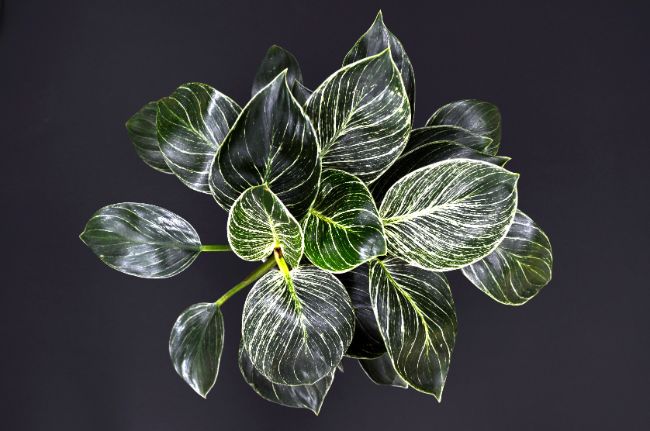
Philodendron Birkin Soil Requirements
Philodendron Birkin does best in soil that is well-draining but doesn’t dry out too quickly. When you get your plant it will likely be potted in pure peat or coco coir, but there’s no need to rush to repot your plant immediately.
However, when repotting your plant, switch to one of these alternatives, to provide a better environment for your plant.
- 2/3 houseplant potting mix and 1/3 perlite or coarse sand.
- 2/3 peat or coco coir and 1/3 perlite or coarse sand.
- A specialist aroid mix is a great option for Philodendron Birkin. I buy mine online from Etsy.
Humidity Requirements
Philodendron Birkin has slightly waxy and fairly thick leaves, so it is much less fussy about humidity than some other houseplants. However, if it is particularly arid in your home, you may start to see brown tips and edges developing on the leaves.
Humidity levels of >40% are fine to provide adequate Philodendron Birkin care, but pushing this up to 50-70% will promote a more comfortable environment and may help your plant to thrive and grow more easily.
I always use a digital hygrometer in my home to keep an eye on humidity levels for my plants (This is the one I use). I’ve found it so helpful to be able to see the humidity level at a glance and then take steps to adjust it as needed.
If you’re struggling to keep humidity levels up for your Philodendron Birkin, try one of these methods.
- Group your plants together – increased transpiration and evaporation will increase humidity around your plants.
- Use a humidity tray underneath or around your plants.
- Move your plant to a bathroom, where the use of baths, showers, and taps will provide greatly increased humidity.
- Use a humidifier to easily increase humidity to whatever level you need.
- See this article for more ways to increase humidity for your houseplants.
Temperature Requirements
As long as you keep temperatures within the range of 60-85°F(16-30°C), your Philodendron Birkin will be perfectly happy. It will typically stop growing below 60°F (16°C) and can suffer cold damage below 50°F (10°C).
The main thing that can cause temperature issues indoors is drafts. Both hot and cold drafts can cause problems. Hot drafts from radiators, heating vents or fires can cause browning of the leaves, particularly at the edges and tips.
Cold, drafty windows or cooling vents can cause considerable cold stress and result in a plant failing to thrive or worse.
How To Fertilize Philodendron Birkin
The best way to fertilize Philodendron Birkin is by using a water-soluble fertilizer every 2-4 weeks. I normally fertilize my Philodendron Birkin every second or third time it needs watering. I use a water-soluble, balanced (20-20-20) fertilizer that I make up to half the recommended strength for outdoor plants. Here is a link to the fertilizer I use.
Organic fertilizers are equally appropriate, and usually carry less risk of overfertilizing, but tend to work more slowly.
Another option is to add 10% compost or worm castings to the potting soil when repotting. This will normally provide sufficient nutrients for your plant for at least 1-2 growing seasons but does impair the drainage of the soil a little.
Pruning
Minimal pruning is required other than to remove any dead or damaged leaves as you feel is appropriate. Remember to use a pair of sharp, sterile pruning shears to reduce the risk of disease.
Repotting
Philodendron Birkin is a relatively fast-growing plant, and you should check it for signs of becoming rootbound at least once a year. If you want to maximize the growth of your plant, you should repot once roots start growing out of the bottom of the pot. Here are some tips for repotting;
- Increase the pot size but no more than 1-2 inches, as up-potting by too much can increase the risk of overwatering and root rot issues.
- Check the health of the roots when repotting, as this will give you some valuable feedback on whether you have been doing a good job with watering.
- If you see any signs of root rot, prune off all affected roots before repotting. Make sure to use sterile pruning shears and clean them afterward.
- Repot in a well-draining potting mix such as those discussed previously.
Philodendron Birkin tolerates repotting quite well and it is unlikely to suffer much following the repotting process. Nonetheless, repotting is a stressful time for your plant, so make sure to pay extra close attention to caring for it in the first few weeks after repotting.
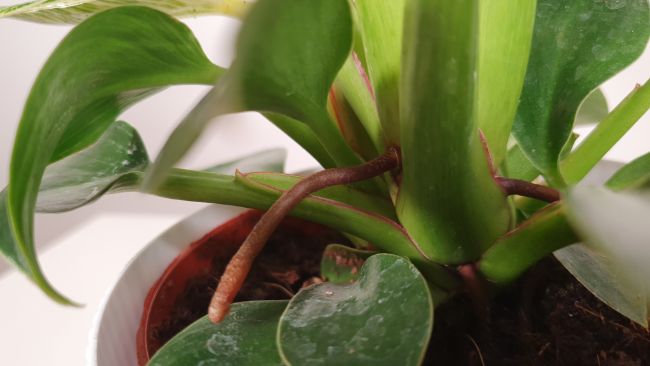
How To Propagate Philodendron Birkin
The best way to propagate Philodendron Birkin is by stem cuttings. It’s best to take cuttings in spring when the plant will be growing strongly, and any cuttings will have the best chance of growing successfully.
It’s really important to make sure your cuttings have at least one growth node on them, and ideally a few aerial roots to maximize the chance of success.
You can propagate your cuttings in water for 6-8 weeks until there are plenty of new roots growing, and then plant them in potting mix.
Alternatively, you can plant your cuttings directly in soil. I tend to find that water propagation has a higher success rate, but the roots tend to grow more slowly. There is also a risk of failure when you transfer water propagated cuttings into soil.
Here is an awesome video showing you the entire process of propagating your Philodendron Birkin.
Philodendron Birkin Care Tips
- It’s normal for older leaves to turn yellow every now and then as the plant matures. This can be most noticeable in fall and winter when light levels are lower.
- The biggest risk to the health of your Philodendron Birkin is root rot. Using an overly large pot, poorly draining soil, growing in low light, or cool temperatures can all increase the risk of root rot.
- Consider using a moss pole to let the plant climb as it matures. The aerial roots will gladly cling to anything to help them climb.
- Lighting is arguably the most important aspect of Philodendron Birkin care. Provide plenty of bright, indirect light, as low light will make growing a healthy plant an uphill struggle. Read my guide to lighting for houseplants to learn more.
Can Philodendron Birkin Revert?
Philodendron Birkin’s variegation is unstable due to its origin as a spontaneous chimeric mutation of Philodendroon Rojo Congo. The plant can revert to being completely green, but it can also produce leaves that look completely different to the rest of the plant.
Half-moon variegated leaves, entirely white leaves, and leaves that look just like Philodendron Rojo Congo or Philodendron Prince of Orange have been reported.
Does Philodendron Birkin Climb?
Philodendron Birkin will readily climb if given the opportunity. Without support, such as using a moss pole, it will become very top heavy over time. The growth habit is not dissimilar to that of Philodendron erubescens.
Why Is My Philodendron Birkin Dying?
The most common cause of a Philodendron Birkin dying or struggling is overwatering or root rot. Anything that creates soggy, poorly aerated conditions in the soil will cause root rot. This is both the most common and the most serious issue you may encounter with Philodendron Birkin care.
Factors such as growing your plant in low light, using poorly draining soil, using a pot with insufficient drainage, a pot that is too large, or simply not checking to see if the soil feels dry before watering are all common causes of root rot.
Another common problem that can cause major health problems for your Philodendron Birkin is growing in insufficient light, which will cause your plant to fail to grow and struggle over time.
Why Does My Philodendron Birkin Have Yellow Leaves?
The most common cause of yellow leaves on a Philodendron Birkin is overwatering. This is often the first sign of a plant that is growing in soggy conditions. Excess direct sunlight, acclimation, and cold stress can also cause leaf yellowing. Occasionally a few lower leaves can turn yellow due to old age, but this is nothing to worry about.
Why Does My Philodendron Birkin Have Brown Tips And Leaf Edges?
Low humidity, underwatering and excess heat and light are the most common causes of brown leaf tips and edges on a Philodendron Birkin. Bear in mind that an overwatered plant can also develop brown leaf tips, but this will usually be accompanied by other symptoms of root rot.
Philodendron Birkin Size
Philodendron Birkin has a spread of approximately 2 feet (60cm) at maturity and can reach several feet in height. This is still quite a new cultivar, so there is some debate regarding the potential height of a fully grown specimen.
Pests
Houseplant pests aren’t usually a major problem with Philodendron Birkin care, but you still need to check your plant regularly and deal with any pests before an infestation gets too severe.
Spider mites, mealybugs, scale, and thrips are the most likely bugs you’ll see, and spider mites are the most likely to cause significant damage. This is partly due to their destructive nature, but partly due to how difficult they can be to spot, resulting in the detection of most infestations at a more advanced stage.
Inspect your plant on a regular basis, taking care to look at both sides of the leaves, as well as along the stems, where bugs can hide expertly.
Once detected, you should quarantine the plant from any of your other houseplants. Start by manually removing as many bugs as possible using either a damp cloth or a jet of water from a hose or showerhead.
After this, spray the plant thoroughly with neem oil, horticultural soap, or isopropyl alcohol to deal with any remaining bugs. I normally recommend keeping the plant separate from the rest of your houseplants and treating it on a weekly basis until you are confident the pests have been dealt with.
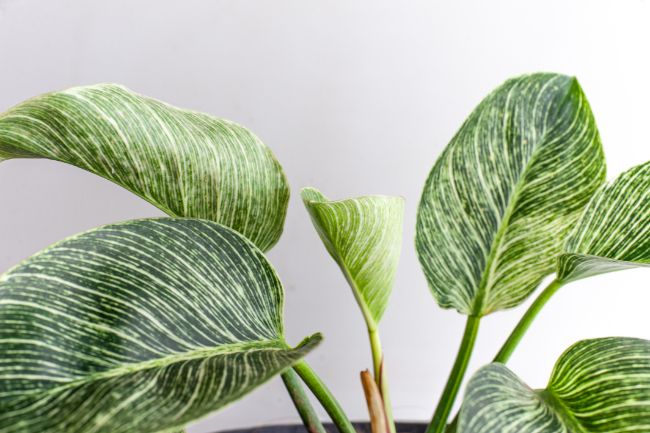
Diseases
The main diseases you will encounter on your Philodendron Birkin are much more likely to occur on a plant that has been overwatered.
Xanthomonas can cause bacterial leaf spot, resulting in dark, wet-looking spots with yellow halos on the leaves.
Erwinia can cause bacterial blight resulting in rapidly spreading, small dark spots on the leaves. The leaves will quickly collapse and die if left untreated.
The best treatment for bacterial and fungal diseases affecting the foliage of your Philodendron Birkin is to prune off all affected foliage and ensure that your plant is growing in optimal conditions. Checking your plant regularly can allow you to detect and treat these issues quickly and effectively, without impacting the health of the entire plant unduly.
Toxicity
Philodendron Birkin is mildly toxic if ingested, and can result in nausea, vomiting, abdominal pain, and diarrhea. It is also possible that it could cause a localized skin reaction if you are handling or pruning it.
Last Word
Hopefully, I’ve covered all of your questions about Philodendron Birkin care and you can concentrate on growing this beautiful houseplant. If you are running into problems, just think about each aspect of care in turn and make a few adjustments to ensure you are giving this plant exactly what it needs.
If you’d like to check out some more Philodendrons to add to your collection, I’ve written an ultimate guide to 50 of the most beautiful Philodendrons, with pictures and descriptions of each.
Alternatively, you may be interested in these related articles.

